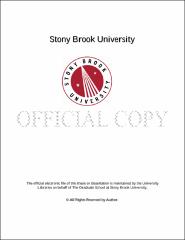| dc.identifier.uri | http://hdl.handle.net/11401/77149 | |
| dc.description.sponsorship | This work is sponsored by the Stony Brook University Graduate School in compliance with the requirements for completion of degree. | en_US |
| dc.format | Monograph | |
| dc.format.medium | Electronic Resource | en_US |
| dc.language.iso | en_US | |
| dc.publisher | The Graduate School, Stony Brook University: Stony Brook, NY. | |
| dc.type | Thesis | |
| dcterms.abstract | Lithium iron(II) phosphate, also known as lithium ferrophosphate (LiFePO<sub>4</sub>, LFP), has been the subject of many recent energy storage studies. As a battery cathode material, LFP has many advantages for commercial applications. Compared to its competitors like LiMn<sub>2</sub>O<sub>4</sub> and the ubiquitous but carcinogenic LiCoO<sub>2</sub>, LFP (specific energy = 600 Wh/kg) exhibits low toxicity, low cost, good thermal stability, and excellent electrochemical performance at high charge/discharge rates. As part of the efforts to understand and improve LFP, a great amount of research has been committed towards developing, characterizing, and electrochemically testing chemical relatives of this phase. In this work, chemical relatives of LFP belonging to the Li<sub>3</sub>PO<sub>4</sub>-Fe<sub>3</sub>(PO<sub>4</sub>)<sub>2</sub>-InPO<sub>4</sub> phase system were investigated. This has lead to the discovery of lithium iron(II) indium phosphate [LiFeIn(PO<sub>4</sub>)<sub>2</sub>, LFIP]. Structural studies on LFIP using laboratory and synchrotron X-ray, neutron, and electron diffraction techniques have demonstrated this phase to crystallize in the orthorhombic space group <italic>Pbca</italic> with lattice parameters <italic>a</italic> = 9.276(1) Å, <italic>b</italic> = 13.757(2) Å, and <italic>c</italic> = 9.476(1) Å. Unlike LFP, this new material does not perform well as a battery cathode as found by chemical delithiation tests, electrochemical cycling, and bond-valence sum difference maps of Li<super>+</super> diffusion pathways. LFIP has also been characterized by magnetic and optical measurements. The material does not order magnetically above 2 K, is paramagnetic with weak antiferromagnetic interactions, and has an effective magnetic moment of 5.39 <italic>µ</italic><sub>B</sub>/Fe. LFIP has a band-gap energy of 2.94 eV and d orbital ligand field splitting energies of 0.75 eV and 0.99 eV. Based on our synthesis results, a preliminary assessment of the Li<sub>3</sub>PO<sub>4</sub>-Fe<sub>3</sub>(PO<sub>4</sub>)<sub>2</sub>-InPO<sub>4</sub> phase system is presented. | |
| dcterms.abstract | Lithium iron(II) phosphate, also known as lithium ferrophosphate (LiFePO<sub>4</sub>, LFP), has been the subject of many recent energy storage studies. As a battery cathode material, LFP has many advantages for commercial applications. Compared to its competitors like LiMn<sub>2</sub>O<sub>4</sub> and the ubiquitous but carcinogenic LiCoO<sub>2</sub>, LFP (specific energy = 600 Wh/kg) exhibits low toxicity, low cost, good thermal stability, and excellent electrochemical performance at high charge/discharge rates. As part of the efforts to understand and improve LFP, a great amount of research has been committed towards developing, characterizing, and electrochemically testing chemical relatives of this phase. In this work, chemical relatives of LFP belonging to the Li<sub>3</sub>PO<sub>4</sub>-Fe<sub>3</sub>(PO<sub>4</sub>)<sub>2</sub>-InPO<sub>4</sub> phase system were investigated. This has lead to the discovery of lithium iron(II) indium phosphate [LiFeIn(PO<sub>4</sub>)<sub>2</sub>, LFIP]. Structural studies on LFIP using laboratory and synchrotron X-ray, neutron, and electron diffraction techniques have demonstrated this phase to crystallize in the orthorhombic space group <italic>Pbca</italic> with lattice parameters <italic>a</italic> = 9.276(1) Å, <italic>b</italic> = 13.757(2) Å, and <italic>c</italic> = 9.476(1) Å. Unlike LFP, this new material does not perform well as a battery cathode as found by chemical delithiation tests, electrochemical cycling, and bond-valence sum difference maps of Li<super>+</super> diffusion pathways. LFIP has also been characterized by magnetic and optical measurements. The material does not order magnetically above 2 K, is paramagnetic with weak antiferromagnetic interactions, and has an effective magnetic moment of 5.39 <italic>µ</italic><sub>B</sub>/Fe. LFIP has a band-gap energy of 2.94 eV and d orbital ligand field splitting energies of 0.75 eV and 0.99 eV. Based on our synthesis results, a preliminary assessment of the Li<sub>3</sub>PO<sub>4</sub>-Fe<sub>3</sub>(PO<sub>4</sub>)<sub>2</sub>-InPO<sub>4</sub> phase system is presented. | |
| dcterms.available | 2017-09-20T16:52:05Z | |
| dcterms.contributor | Khalifah, Peter G | en_US |
| dcterms.contributor | Marschilok, Amy | en_US |
| dcterms.contributor | Parise, John. | en_US |
| dcterms.creator | Saccomanno, Michael Richard | |
| dcterms.dateAccepted | 2017-09-20T16:52:05Z | |
| dcterms.dateSubmitted | 2017-09-20T16:52:05Z | |
| dcterms.description | Department of Chemistry. | en_US |
| dcterms.extent | 75 pg. | en_US |
| dcterms.format | Monograph | |
| dcterms.format | Application/PDF | en_US |
| dcterms.identifier | http://hdl.handle.net/11401/77149 | |
| dcterms.issued | 2014-12-01 | |
| dcterms.language | en_US | |
| dcterms.provenance | Made available in DSpace on 2017-09-20T16:52:05Z (GMT). No. of bitstreams: 1
Saccomanno_grad.sunysb_0771M_12061.pdf: 5068179 bytes, checksum: 03f1dafedf6645d04bdf7dafb9cd71f8 (MD5)
Previous issue date: 1 | en |
| dcterms.publisher | The Graduate School, Stony Brook University: Stony Brook, NY. | |
| dcterms.subject | Chemistry | |
| dcterms.subject | Electrochemistry, Lithium iron(II) indium phosphate, Phase discovery, Solid-state synthesis | |
| dcterms.title | Synthesis and Characterization Studies of Li-Fe-In-(PO4) Phases: Chemical Relatives of Battery Cathode Material Lithium Iron Phosphate | |
| dcterms.type | Thesis | |

